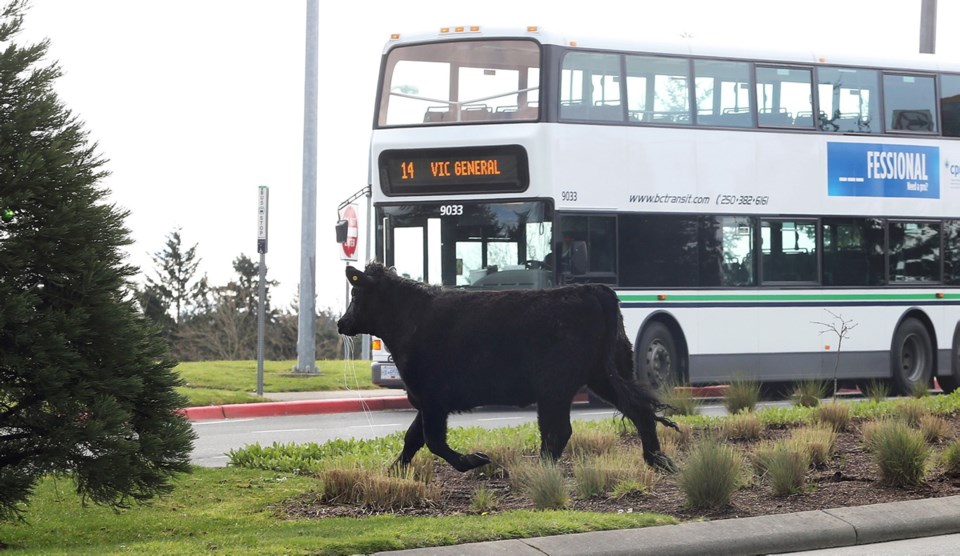 After two months on the run, the Rogue Cow of Metchosin may be roaming its last, and I am sad.
After two months on the run, the Rogue Cow of Metchosin may be roaming its last, and I am sad.
No more will it emerge from its hideout in the hills to graze alongside its friends the deer.
No longer will its sudden appearance on the forest’s edge spook horses on Happy Valley Road.
No more will we be able to live vicariously through an animal that dared to dream of freedom.
This story goes back to May, when a previously placid Metchosin cow suddenly turned its head to the horizon, gazed into the future and took off over the hedgerow like Steve McQueen in The Great Escape.
It has been living off the land ever since, leading a Barefoot Bandit life, startling backroad drivers, surprising Galloping Goose hikers, shaking down children for their lunch money, stealing tractors. Basically it’s a Far Side cartoon come to life. And the longer it remains at large, the larger its legend grows.
Lord knows the farmer has tried to bring it in, chasing it for kilometres at a time, staking (steaking?) out a neighbour’s field where it is known to appear with the deer. No luck. He now knows where every bear in Metchosin lives, but the black cow — an Angus steer, we presume — is elusive.
OK, this is one of those tales that is funny if you’re not personally involved but serious if you are. The municipality, Mounties, SPCA and Capital Regional District have all had calls. A horse broke out of its paddock after being startled by the cow, had to get its hips adjusted by an equine chiropractor. The owner wasn’t impressed.
So now the CRD has given the farmer a couple of days to round up the Rogue Cow. If that doesn’t work, they’re sending in a Bossy posse of their own to capture the critter, says chief bylaw officer Don Brown.
They could write daily $100 animal-at-large tickets if they wanted to get sticky about it, but what they really want is to get the cow back home, as livestock can present a problem when let loose among people. (You might recall the brief-but-entertaining rodeo featuring Mounties, Saanich police, firefighters and animal control officers that broke out in 2015 after two cows headed from their Saanich farm to a slaughterhouse in Duncan somehow managed to break out of their trailer, halting noon-hour traffic on the Trans-Canada Highway at Helmcken Road.)
It doesn’t surprise Brown that livestock escape, but he does find it odd when owners don’t report a valuable animal as missing. “We had a llama at large once. Nobody ever claimed it.”
The thing is, when human-owned animals do break loose, people often root for the runner.
It happened with Lucy the Emu, the man-sized flightless bird that nonetheless took flight from a Nanaimo-area farm in 2014. For six days the only thing captured was the public’s imagination as this giant, cartoonish Australian chicken bolted for liberty.
It happened with the two capybaras that became instant folk heroes after busting out of Toronto’s High Park Zoo and running wild for several weeks in 2016. (Their three offspring were named after the members of the band Rush this week.)
And it happens a lot with cattle. Who can forget Yvonne, the dairy cow who became a German media darling after taking to the woods in 2011? She evaded capture for three months despite a 10,000-euro bounty, a shoot-to-kill order and an attempt to woo her with what was described as “the George Clooney of bulls.”
In 2002, a Charolais cow who remained on the lam for 11 days after leaping a six-foot fence to escape an Ohio slaughterhouse was christened Cincinnati Freedom by artist Peter Max, who was allowed to take her into his care after offering $180,000 US worth of paintings to the SPCA. She lived out her days at an animal sanctuary in New York state.
In Massachusetts, a heifer named Emily managed to elude capture for 40 days, some say with the help of sympathetic townsfolk, in 1995. A full-size bronze statue of Emily now stands over her grave.
In March of this year, rival crowdfunding groups wrestled over who would get to save Chico the steer, a slaughterhouse refugee who was cheered by onlookers while rampaging through St. Louis for several hours.
On the other hand, no one crowdfunded to save the Snake In A Drain, the five-foot serpent freed from a Quadra Street sewer pipe by city workers last year. (The corn snake did survive, though, going on to become a political analyst on Fox News.) Also, no one complained when the B.C. government announced open season on feral pigs, the descendants of farm escapees. To quote George Orwell: “All animals are equal but some animals are more equal than others.”
Or maybe we just identify with some animals more than others. Maybe there’s a little Rogue Cow of Metchosin in all of us, yearning to shed our shackles and clear the cubicle/corral.



